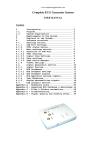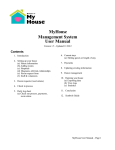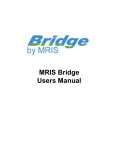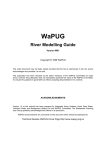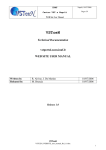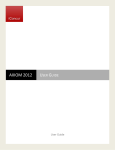Download User Guide - African Development Bank Fragile States Portal
Transcript
Fragile States Portal USER GUIDE Copyright © 2012 Prognoz Corporation. All rights reserved. All trademarks are the property of their respective owners. No portion of this user guide may be reproduced or transmitted in any form or by any means, electronic or mechanical, including photocopying, recording, or information storage and retrieval systems, for any purpose other than the recipient’s personal use, without the express written permission of Prognoz. The information contained in this user guide is subject to change without notice. While every effort has been made to ensure the accuracy and reliability of this information, neither Prognoz nor its partners or affiliates shall be liable for errors contained herein or consequential damages in connection with the furnishing, performance, or use hereof. The software described herein is licensed subject to the conditions set forth in the software services agreement. Document version 1.0 Table of contents 1. Using the Portal ................................................................................................ 7 About the Fragile States Portal ................................................................................................. 8 System requirements ................................................................................................................... 9 Using Overview ........................................................................................................................10 2. Data Search ..................................................................................................... 11 About Data Search.....................................................................................................................13 Searching the data ......................................................................................................................14 Navigating the results .........................................................................................................15 Viewing the data ..................................................................................................................15 Printing and exporting the results ..........................................................................................16 Printing the results ..............................................................................................................16 Exporting the results ..........................................................................................................16 3. Maps .................................................................................................................. 17 About Maps .................................................................................................................................19 Using the map .............................................................................................................................20 Visualizing a source and an indicator on the map ........................................................20 Visualizing stability and instability factors on the map ................................................23 Using the legend ..................................................................................................................26 Viewing Country Profile.....................................................................................................28 Exporting the map ......................................................................................................................30 4. Data Analysis ................................................................................................... 31 About Data Analysis ..................................................................................................................33 Loading a preset data view ................................................................................................33 Selecting elements from the dimensions ........................................................................34 Changing the position of the dimensions .......................................................................36 Undo and redo recent operations...................................................................................37 Working in Table view ..............................................................................................................39 Sorting the table ..................................................................................................................39 Filtering data from the table..............................................................................................39 Highlighting data in the table.............................................................................................40 Adding conditional formatting to the table ...................................................................42 Adding columns and rows for totals ...............................................................................43 Performing a Pareto (80/20) analysis ..............................................................................44 Applying a table style ..........................................................................................................45 Setting the data format.......................................................................................................46 Working in Chart view .............................................................................................................48 Changing the chart type .....................................................................................................48 Showing and hiding chart labels........................................................................................49 Customizing the chart ........................................................................................................49 Changing the range of data displayed on the chart in Table-Chart mode..............50 Hiding the table in Table-Chart mode ............................................................................50 Printing and exporting the results ..........................................................................................51 Printing the results ..............................................................................................................51 Exporting the results ..........................................................................................................51 5. Data Query ...................................................................................................... 53 About Data Query .....................................................................................................................55 Selecting the source...................................................................................................................56 Selecting the elements...............................................................................................................57 Selecting elements from the dimension .........................................................................57 Searching for elements in a dimension ...........................................................................58 Using a dimension’s list context menu ...........................................................................58 Constructing the data view ......................................................................................................59 Viewing the results.....................................................................................................................60 Working in the Table mode..............................................................................................60 Working in the Chart mode .............................................................................................61 Working in the Map mode ................................................................................................62 Printing and exporting the results ..........................................................................................64 Printing the results ..............................................................................................................64 Exporting the results ..........................................................................................................64 6. Dashboards ...................................................................................................... 65 About Dashboards .....................................................................................................................67 Working with dashboard visualizations.................................................................................68 Printing and exporting the dashboard document ...............................................................69 Printing the results ..............................................................................................................69 Exporting the results ..........................................................................................................69 7. Data by topics .................................................................................................. 71 About Data by Topics ...............................................................................................................72 Exploring report types ..............................................................................................................73 Viewing a report ..................................................................................................................73 Customizing a report..........................................................................................................74 Using the dimension box’s context menu .....................................................................74 Printing and exporting the results ..........................................................................................75 Printing the results ..............................................................................................................75 Exporting the results ..........................................................................................................76 8. Resource Center ............................................................................................. 77 9. About ................................................................................................................ 78 5 1 Using the Portal In this chapter About the Fragile States Portal ................................................................................................. 8 System requirements ................................................................................................................... 9 Using Overview ..........................................................................................................................10 7 About the Fragile States Portal The Fragile States Portal provides many advanced features for analyzing, visualizing, and reporting economic and social data for all African countries including fragile states. The portal’s functionality works entirely in a Web browser such as Microsoft Internet Explorer, Google Chrome and Mozilla Firefox. This user guide describes the portal’s features and provides step-by-step instructions for using them. 8 System requirements To ensure trouble-free operation of the Fragile States Portal, please check that your computer meets the following requirements. Operating system Any Browser Microsoft Internet Explorer 7.0 or higher, Mozilla Firefox 16 or higher, Google Chrome 23 or higher Additional software Microsoft Word, Microsoft Excel, and Adobe Acrobat Reader are recommended for opening certain types of downloadable content 9 Using Overview The Overview page contains brief information about the portal. 10 2 Data Search In this chapter About Data Search.....................................................................................................................13 Searching the data ......................................................................................................................14 Navigating the results .........................................................................................................15 Viewing the data ..................................................................................................................15 Printing and exporting the results ..........................................................................................16 Printing the results ..............................................................................................................16 Exporting the results ..........................................................................................................16 11 About Data Search The Data Search page of the portal enables you to search any indicator data in any of the data sources of the Fragile States Portal. To browse to the Data Search page, choose Data Search from the navigation bar. 13 Searching the data To search the data according to any criteria, do the following: Type the search criteria in the search field. The portal starts the searching process automatically. TIP Search string may contain the logical operators AND and OR and the operands () and “”. AND searches for both words and phrases, while OR searches for one or the other. If the search string uses AND and OR at the same time, the AND operation takes priority, unless you enclose the OR operation in parentheses, as in (A or B) and C. To find an exact phrase, such as “mozambique population,” enclose the phrase in quotes. After the search finishes, the list of data series found will be displayed under the search field. To filter the data by a data source, do the following: Open the Source drop-down menu on the left-side if the search field: Select the data source name to search the data in this data source. NOTE All the sources are selected by default, so by default the search returns results from all the portal’s data sources. 14 Navigating the results If the search returns a large number of data series, use the navigation bar under the list of results: To go to a results page, click its number button. To go to the subsequent results page, click the Next button. To go to the previous results page, click the Previous button. Viewing the data The Data Search tool enables you to view the data of the found data series. To view the full data of the data series in Table-Chart mode click the desired data series name in the results list. 15 Printing and exporting the results The portal enables you to print the table and chart on your printer or export them to one of two external file formats. Printing the results To print the results, follow these steps: Click the Print Preview button in the toolbar. The portal opens a new browser window containing a printer-friendly version of the results. Click the browser’s Print button. Your browser sends the printerfriendly version of the results to your printer. Exporting the results The portal enables you to export the table and chart to one of two external file formats. To export the results to an external file format, follow these steps: Open the data series in the table-chart mode modal window. In the toolbar, click the button corresponding to the file type to which you want to export the results: Export to XLS . This format opens in Microsoft Excel. Export to PDF . This format opens in Adobe Acrobat. The portal opens a new browser window, prepares the external file, and initiates your browser’s procedure for downloading files. For example, in Microsoft Internet Explorer, the File Download dialog box appears; click Save to save the exported file to your computer. 16 3 Maps In this chapter About Maps .................................................................................................................................19 Using the map .............................................................................................................................20 Visualizing a source and an indicator on the map ........................................................20 Visualizing stability and instability factors on the map ................................................23 Using the legend ..................................................................................................................26 Viewing Country Profile.....................................................................................................28 Exporting the map ......................................................................................................................30 17 About Maps The Maps page of the portal enables you to visualize any indicator in any of several preset years on an interactive map of Africa. To browse to the Maps page, choose Maps from the navigation bar. 19 Using the map The map offers several convenient functions, all of which you can activate with one or two mouse clicks. Visualizing a source and an indicator on the map By default, only fragile-eligible countries data is available on the map. Other countries are grayed out. To show non-empty indicators only, check the checkbox above the left panel. To display data for other countries, open the dimension box above the map and select a desired map view. 20 NOTE If you check the checkbox when change a map view, indicators list will change. , To visualize an indicator on the map, click the desired indicator in the list on the left. The portal visualizes the selected elements on the map. To change the year, click the year point directly below the map. To show the country flag, hover over the desired country with the mouse pointer. 21 22 Visualizing stability and instability factors on the map The Maps page of the portal enables you to visualize specific indicator (stability and instability) on an additional layer of the map. This kind of data is displayed for fragile states only. To select stability and instability factors, open dimension box on the right panel and select needed indicators. The quantitative indicators are displayed as a histogram over the corresponding country. Select the Legend tab on the right panel to see the histogram’s legend. NOTE You are able to display only five factors simultaneously. 23 24 To display CSOs icons on the map do the following: select the CSO item in the dropdown list on the right panel select the CSOs tab click on the desired CSO type. You will see icons with corresponding type over fragile states. To show information about CSOs, hover over the desired icon with the mouse pointer. To show information about Private Security Company, select the RPSCs tab and hover over the desired range with the mouse pointer. 25 NOTE If you do not see corresponding tab, you need select a desired indicator in the dropdown list of stability and instability indicators. Using the legend The map’s legend enables you to highlight only those provinces that belong to a specific range of data. 26 To highlight the country with specific range of data, hover over the desired range with the mouse pointer. You do not need to click the mouse button to see this effect. To focus on a particular region of the map, such as Central Africa, switch to the Locations tab, and choose the desired region. 27 Viewing Country Profile The Maps page of the portal enables you to display key information about a country. Details of the currently selected country include a brief description and two charts. 28 To view details for a particular country, click this country on the map. To select country or regional organization, click the desired country/regional organization in the list on the left. To revert to Map view, click the button above the description. NOTE If only the fragile states data are displayed on the map, you are still allowed to go to the Country Profiles of non-fragile states. 29 Exporting the map The Maps page of the portal enables you to export any indicator in any of several preset years to the PNG graphics file format. To export map to a PNG file, click the Export button above the map. 30 4 Data Analysis In this chapter About Data Analysis ..................................................................................................................33 Loading a preset data view ................................................................................................33 Selecting elements from the dimensions ........................................................................34 Changing the position of the dimensions .......................................................................36 Undo and redo recent operations...................................................................................37 Working in Table view ..............................................................................................................39 Sorting the table ..................................................................................................................39 Filtering data from the table..............................................................................................39 Highlighting data in the table.............................................................................................40 Adding conditional formatting to the table ...................................................................42 Adding columns and rows for totals ...............................................................................43 Performing a Pareto (80/20) analysis ..............................................................................44 Applying a table style ..........................................................................................................45 Setting the data format.......................................................................................................46 Working in Chart view .............................................................................................................48 Changing the chart type .....................................................................................................48 Showing and hiding chart labels........................................................................................49 Customizing the chart ........................................................................................................49 Changing the range of data displayed on the chart in Table-Chart mode..............50 Hiding the table in Table-Chart mode ............................................................................50 Printing and exporting the results ..........................................................................................51 Printing the results ..............................................................................................................51 Exporting the results ..........................................................................................................51 31 About Data Analysis The Data Analysis page of the portal offers a powerful tool for slicing and visualizing the data. The data is provided in several dimensions, such as Calendar, Regions, and Indicators. To browse to the Data Analysis page, choose Data Analysis from the navigation bar. Loading a preset data view Data Analysis provides several preset data views organized into categories like SocioEconomic Database and Food prices. The categories appear as the Sources list on the left side of the browser window. 33 To load a preset data view, click a data view. The portal makes the necessary selections from the dimensions and displays the corresponding data in the results area. NOTE After you load a preset data view, you can change the selection in the dimensions however you choose. However, your changes are not permanent; the next time you load the same preset data view, the portal uses its built-in selections rather than your modified ones. Selecting elements from the dimensions The data dimensions appear in dimension boxes on the left side of the interface. These dimension boxes contain selectable elements or items, which represent the data that appears in the results area. All the dimensions are structured, in that they organize their elements into a two- or three-tiered hierarchy. For example, the Trade Index element in Indicators is further divided into two separate subelements: Index of Intra-African trade and Index of External trade. To open a dimension box, click the inverted triangle on its right side. A drop-down menu of selectable elements appears. To close the dimension box, click anywhere outside it. To expand a parent element in the Indicators dimension, click the triangle icon to the left of the parent element’s name. The child elements for this parent appear. To view more elements in the dimension box, scroll to the bottom of the drop-down menu (or the bottom of the list of child elements under a parent element) and click Next. If you do not see a Next choice, there are no more elements to display. To resize the dimension box, drag the handle in the upper right corner of the drop-down menu. To select or deselect an element from the dimension box, click the element in the drop-down menu. 34 NOTE The dimensions in the Columns and Rows positions accept multiple element selections, while the dimension in the Fixed position accepts a single selection only. (See “Changing the position of the dimensions” later in this chapter for more information.) Using the dimension box’s context menu You can also right-click any element in the open dimension box for a context menu of time-saving commands: Select All. The portal selects all the elements in the dimension. Deselect All. The portal deselects all the elements in the dimension. Select Level. The portal selects all the elements at the same level in the hierarchy as current element. Deselect Level. The portal deselects all the elements at the same level in the hierarchy as the current element. Select Dependent. The portal selects all the child elements of the current parent. Deselect Dependent. The portal deselects all the child elements of the current parent. Collapse all. The portal collapses all parent elements. Expand all. The portal expands all parent elements. NOTE Not all context menu commands are available in every dimension box. TIP If present data view has not changed after changing of selecting elements from the dimensions, you need to click the Refresh button or put a tick in the toolbar to refresh the current table values. 35 Changing the position of the dimensions The dimensions appear under three positions: Columns, Rows, and Fixed. The Columns and Rows represent the columns and rows of the table in the results area, while the Fixed position represents the values in the cells of the table. By default, the Calendar dimension is in the Columns position, the Indicators dimension is in the Rows position, and the Regions dimension and Units dimensions is in the Fixed position. 36 To change the position of a dimension, drag the dimension from its current position, and drop it under the desired position. The portal displays a blue line to show you where the dragged dimension will go. To lock a position, click the triangle icon to the right of the position’s name. While locked, the position’s dimensions are hidden from view. You cannot move dimensions to or from the locked position, and you cannot change the element selection inside the affected dimensions. Click the triangle icon again to unlock the position. To invert the dimensions in rows and columns quickly, click the Rotate Table button in the toolbar above the Table view (see “Working in Table view” later in this chapter for more information). TIP If present data view has not changed after changing the position of the dimensions, you need to click the Refresh button or put a tick in the toolbar to refresh the current table values. Undo and redo recent operations To undo the most recent change to the data dimensions or the results area, click the Back button in the toolbar above Table view. To redo an action that you previously undid, click the Forward button . 37 NOTE Not all actions are undoable. 38 Working in Table view Table view shows data in a table form. This view appears by default in Data Analysis. You can also show the table by clicking the Table Mode button , the Chart Mode button , or the Table-Chart Mode button in the toolbar. This section covers the portal’s various commands and options for working with data in Table view. Sorting the table To sort the table, click the grey inverted triangle of the column by which you want to sort. The icon changes to a dark-grey inverted triangle , meaning that the table is sorted in descending order according to the values in this column. Click the icon a second time, and it changes to a dark-grey triangle , meaning that the table is sorted in ascending order according to the values in this column. Click the icon a third time to revert it to the grey inverted triangle and turn off table sorting. Filtering data from the table The portal enables you to hide or filter data from the table when this data matches a specific type or meets a certain condition. To filter data from the table, follow these steps: 39 Click the Filter button in the toolbar above Table view. The Data Filtering Settings dialog box appears: Check or uncheck general filtering options: Hide zero cells. Check this option to hide table cells containing the value 0. Hide empty cells. Check this option to hide table cells containing no value whatsoever. This option does not filter table cells whose value is equal to 0. Hide non-numeric cells. Check this option to hide table cells containing letters or symbols but no numbers. Choose a filtering condition from the Hide Cells Satisfying Condition drop-down menu, and then type values in the A and B fields as required. The A and B values correspond to the variables A and B in the condition statement. If your filtering condition does not require a B value, then this field remains uneditable. Click Ok. The Data Filtering Settings dialog box closes, and the portal applies the filter to the table. TIP To remove the filter from the table, choose None from the Hide Cells Satisfying Condition drop-down menu and then click Ok, or simply click Clear at the bottom of the Data Filtering Settings dialog box. Highlighting data in the table To highlight data in the table, follow these steps: 40 Click the Data Highlighting button in the toolbar above Table view. The Data Highlighting Settings dialog box appears: Choose a highlighting condition from the Condition drop-down menu, and then type values in the A and B fields as required. The A and B values correspond to the variables A and B in the condition statement. If your highlighting condition does not require a B value, then this field remains non-editable. Set the format of the highlighting effect: Cell background. Choose a color from the color swatches to use as the background color of a highlighted cell. The default is white. Font size. Choose a font size for the text or value in a highlighted cell. The units are points, and the default is 11. Color. Choose a color for the text or value in a highlighted cell. The default is red. Bold. Check this option to use boldface for the text or value in a highlighted cell. This option is checked by default. Italic. Check this option to use italics for the text or value in a highlighted cell. This option is unchecked by default. Underline. Check this option to underline the text or value in a highlighted cell. This option is unchecked by default. Click Ok. The Data Highlighting Settings dialog box closes, and the portal highlights all table data that meets the criteria established in Step 2 using the appearance attributes that you specified in Step 3. 41 TIP To remove the highlighting effect from the table, choose None from the Condition drop-down menu and then click Ok, or simply click Clear at the bottom of the Data Highlighting Settings dialog box. Adding conditional formatting to the table Conditional formatting uses a color gradient or a graphical icon to indicate the relative value in any given table cell. To add conditional formatting, follow these steps: Click the Conditional Formatting button in the toolbar above Table view. The Conditional Formatting dialog box appears: Choose a color scale or icon set to apply to the table values. Click OK. The Conditional Formatting dialog box closes, and the portal applies the conditional formatting scheme to the values in the table cells. TIP To remove conditional formatting from the table, click Clear at the bottom of the Conditional Formatting dialog box. 42 Adding columns and rows for totals The portal enables you to add totals columns or totals rows, which are columns or rows of the table containing sums, averages, or other common mathematical functions. To add totals to the table, follow these steps: Click the Totals button in the toolbar above Table view. The Totals Settings dialog box appears: Check the total types under Rows or Columns that you would like to add. Checking items under Rows adds the designated rows to the table, while checking items under Columns adds the designated columns. You may add as many of each as you like. 43 Check the Treat Empty Values As Zeroes option to make the portal assume the value of 0 for table cells that do not have any value. Doing so can affect the results of certain totals types, or it can have no effect at all. Click Ok. The Totals Settings dialog box closes, and the portal adds the appropriate rows and columns to the table. TIP To remove totals from the table, uncheck the totals to remove, or simply click Clear at the bottom of the Totals Settings dialog box. Please note that clicking the Clear button removes all totals from the table. Performing a Pareto (80/20) analysis In a Pareto or 80/20 analysis, the table shows the top 80% of the results normally and combines the bottom 20% as a single sum. To perform a Pareto analysis on the table, follow these steps: 1. Click the 80/20 Analysis button in the toolbar above Table view. The 80/20 Analysis Parameters dialog box appears: 2. From the Column To Analyze drop-down menu, choose the table column that the portal should use for determining the top 80% and the bottom 20% of the data values. 3. 44 Under Format, choose how the portal should display the Pareto analysis: Cell background .Choose a color from the color swatches to use as the background color of the cells in the column that you chose in Step 2. Font size. Choose a font size for the text or values in the cells of the column that you chose in Step 2. The units are points, and the default is 11. Color. Choose a color for the text or values in the cells of the column that you chose in Step 2. Bold. Check this option to use boldface for the text or values in the cells of the column that you chose in Step 2. Italic. Check this option to use italics for the text or values in the cells of the column that you chose in Step 2. Underline. Check this option to underline the text or values in the cells of the column that you chose in Step 2. 4. Click OK. The 80/20 Analysis Parameters dialog box closes, and the portal applies the Pareto analysis to the table TIP To remove the Pareto analysis from the table, click the Pareto icon at the top of the Pareto column, or open the 80/20 Analysis Parameters dialog box and choose None from the Column To Analyze drop-down menu or click Clear. Applying a table style A table style is a collection of appearance attributes for the table. Applying a table style does not change the values in the table, but it does change the colors that the portal uses to display the table. To apply a table style, follow these steps: 1. Click the Table Style button Style dialog box appears: in the toolbar above Table view. The Table 45 2. Choose a table style by clicking its radio button. 3. Click Ok. The Table Style dialog box closes, and the portal applies the desired table style to the table. TIP To revert to the default appearance of the table, select the Standard style in the Table Style dialog box. Setting the data format The data format determines how the portal displays the values in the table cells. There are four data formats, each of which applies to all the values in the table: General format. The portal displays all data values exactly as they appear in the data source, without rounding. To apply this data format, click the General Format button in the toolbar above Table view. Currency format. The portal displays all data values with a currency symbol and rounds to nearest hundredths by default. To apply this data format, click the Currency Format button in the toolbar above Table view. Percentage format. The portal displays all data values with a percent symbol and rounds to nearest hundredths by default. To apply this data format, click the Percentage Format button toolbar above Table view. 46 in the Delimiter format. The portal rounds all data values to nearest hundredths by default. To apply this data format, click the Delimiter Format button in the toolbar above Table view. TIP To increase the decimal precision of rounded table values in Currency, Percentage, or Delimiter format, click the Increase Decimal button in the toolbar above Table view. To decrease the decimal precision of rounded table values, click the Decrease Decimal button Please note that these buttons do not appear in the toolbar when the table is in General format. . 47 Working in Chart view Chart view visualizes data in chart form. You can also show Chart view by clicking the Chart Mode button or the Table-Chart Mode button in the toolbar. TIP The toolbar buttons for Chart view appear either in the toolbar above the results area when Chart Mode or Table-Chart Mode is active or in the special toolbar above Chart view when Table-Chart Mode is active. This section covers the portal’s various commands and options for working with data in Chart view. Changing the chart type The portal provides various chart types. To change the chart type, click any of the following toolbar buttons: Line. To apply this type of chart, click the Line button . Column. To apply this type of chart, click the Column button . Bar bottom-up. To apply this type of chart, click the Bar BottomUp button . Stacked column. To apply this type of chart, click the Stacked Column button . Stacked bar bottom-up. To apply this type of chart, click the Stacked Bar Bottom-Up button 48 . Area. To apply this type of chart, click the Area button Pie. To apply this type of chart, click the Pie button . Radar. To apply this type of chart, click the Radar button Line/column chart. To apply this type of chart, click the Line/Column Chart button . . . Showing and hiding chart labels To show or hide labels on the chart, click any of the following toolbar buttons: Axis.To show or hide axis labels, click the Axis Labels button Data.To show or hide data labels, click the Data Labels button Legend.To show or hide legend, click the Legend button . . . Customizing the chart To customize the chart in Table-Chart mode or Chart mode, click the Customize chart button . The chart setup dialog box appears. 49 Changing the range of data displayed on the chart in Table-Chart mode To change the range of data displayed on the chart in Table-Chart mode, drag to select the cell or range of cells in Table view that you wish to display in Chart view. The portal redraws the chart to include only the data from the selected cells. You can also select table elements with a single click: To select an entire column of the table, click the header cell at the top of the column. To select an entire row of the table, click the header cell at the left of the row. To select the entire table, click the cell in the upper-left corner of the table, where the header column and the header row intersect. Hiding the table in Table-Chart mode To hide Table view when Table-Chart mode is active, click the Hide Table button in the toolbar above Chart view. The portal reverts to simple Chart mode. To restore the view of the table, click either the Table Mode button or the Table-Chart Mode button . 50 Printing and exporting the results The portal enables you to print the table and chart or your printer or export them to one of two external file formats. Please note that the current mode of the results area—Table mode, Chart mode, or Table-Chart mode—determines exactly what the portal prints or exports. For example, if Table view is currently hidden because you have enabled Chart mode, then the portal ignores the table and prints or exports the chart only. Printing the results To print the results, follow these steps: Click the Print Preview button in the toolbar. The portal opens a new browser window containing a printer-friendly version of the results. Click the browser’s Print button. Your browser sends the printerfriendly version of the results to your printer. Exporting the results To export the results to an external file format, follow these steps: In the toolbar, click the button corresponding to the file type to which you want to export the results: Export to XLS . This format opens in Microsoft Excel. Export to PDF : This format opens in Adobe Acrobat. The portal opens a new browser window, prepares the external file, and initiates your browser’s procedure for downloading files. For example, in Microsoft Internet Explorer, the File Download dialog box appears; click Save to save the exported file to your computer. 51 5 Data Query In this chapter About Data Query .....................................................................................................................55 Selecting the source...................................................................................................................56 Selecting the elements...............................................................................................................57 Selecting elements from the dimension .........................................................................57 Searching for elements in a dimension ...........................................................................58 Using a dimension’s list context menu ...........................................................................58 Constructing the data view ......................................................................................................59 Viewing the results.....................................................................................................................60 Working in the Table mode..............................................................................................60 Working in the Chart mode .............................................................................................61 Working in the Map mode ................................................................................................62 Printing and exporting the results ..........................................................................................64 Printing the results ..............................................................................................................64 Exporting the results ..........................................................................................................64 53 About Data Query The Data Query wizard of the portal offers a powerful tool for data visualization in table, chart, and map mode.. To browse to the Data Query page, choose Data Query from the navigation bar. 55 Selecting the source Start by choosing Source from the Sources list on Select Data Source page. Scroll down to see the whole list of the sources. 56 To select the desired source, click the preset with its title. To go to the next step of the wizard, click Next. Selecting the elements In this step of the wizard, you select the data to be downloaded in the last step of the wizard. To go to the next step of the wizard, click Next. To change the data source, click Back. Selecting elements from the dimension To select the elements from the dimension, do either of the following: Select the dimension by clicking its title in the list on the left side of the browser window, and check the checkboxes near the desired elements. Use the Select All and Deselect All buttons to select or deselect all elements in the list. 57 Searching for elements in a dimension To find an element quickly, use the Search tool above the dimensions elements field. Type the text to find, and the portal displays all element names that contain this sequence of characters in the dimension box’s drop-down menu. Using a dimension’s list context menu You can also right-click any element in the open dimension box for a context menu of time-saving commands: Select All. The tool selects all the elements in the dimension. Deselect All. The tool deselects all the elements in the dimension. Select Level. The tool selects all the elements at the same level in the hierarchy as current element. Deselect Level. The tool deselects all the elements at the same level in the hierarchy as the current element. Select Children. The tool selects all the child elements of the current parent. Deselect Children. The tool deselects all the child elements of the current parent. Expand All. The tool expands all parent elements. Collapse All. The tool collapses all parent elements. NOTE Not all context menu commands are available in every dimension box. 58 Constructing the data view The Construct Data View step enables you to construct the table and chart that will be displayed in the last step of the wizard. Notice that these dimensions are arranged into three positions: Columns, Rows, and Filters, which correspond to the columns, rows, and cell data of the results table. Dimensions in the Filters position can have only one selected element at a time, while dimensions in Columns and Rows positions support multiple element selections. To change the position of a dimension, drag and drop it. To change the order of the dimensions in the field, drag and drop the dimensions. To go to the next step of the wizard, click Next. To change the selection of elements, click Back. 59 Viewing the results The View Results step provides three data visualization types for selected data: table, chart, and map. Working in the Table mode. The Table mode displays data in the table form. This mode is the default view in the Data Query module. To show Table mode, click the Table button in the toolbar. Then do any of the following: To hide the empty values, click the Filter button To increase the decimal precision of rounded table values, click the Increase Decimal button in the toolbar above Table view. To decrease the decimal precision of rounded table values, click the Decrease Decimal button 60 in the toolbar. . To change the visualized fixed element, do any of the following: Select the desired element in the drop-down menu in the top right corner of the browser window. Click the button near the drop-down menu to visualize the next indicator in the list. Click the button near the drop down menu to visualize the previous indicator in the list. Working in the Chart mode The Chart mode enables to display data in chart form. You can show Chart mode by clicking the Chart button . NOTE Use the drop-down menu and buttons near it to change the visualized fixed element (see “Working with Table mode” previously in this chapter). The portal provides seven different chart types. To change the chart type, click any of the following toolbar buttons: Line. To apply this type of chart, click the Line button . Column. To apply this type of chart, click the Column button . Bar bottom-up. To apply this type of chart, click the Bar BottomUp button . Stacked column. To apply this type of chart, click the Stacked Column button . Stacked bar bottom-up. To apply this type of chart, click the Stacked Bar Bottom-Up button . 61 Area. To apply this type of chart, click the Area button Pie. To apply this type of chart, click the Pie button . . NOTE Use the Filter button to hide empty values. Working in the Map mode The Map mode visualizes data on the interactive map of the world. You can show Map mode by clicking the Map button in the toolbar. To visualize an indicator on the map, expand the drop-down menu in the top left corner of the browser window, and click an element to select it. The portal visualizes selected elements on the map. 62 To change the year, click the corresponding year below the map: NOTE Use the buttons near the drop-down menu to change the visualized element. Using the legend The map’s legend enables you to highlight only those countries that belong to a specific range of data. To do so, switch to the Legend tab if necessary, and hover over the desired range with the mouse pointer. You do not need to click the mouse button to see this effect. 63 Printing and exporting the results The portal enables you to print the table and chart or your printer or export them to one of two external file formats. Please note that the current mode of the results area—Table mode, Chart mode, or Table-Chart mode—determines exactly what the portal prints or exports. For example, if Table view is currently hidden because you have enabled Chart mode, then the portal ignores the table and prints or exports the chart only. Printing the results To print the results, follow these steps: Click the Print Preview button in the toolbar. The portal opens a new browser window containing a printer-friendly version of the results. Click the browser’s Print button. Your browser sends the printerfriendly version of the results to your printer. Exporting the results To export the results to an external file format, follow these steps: In the toolbar, click the button corresponding to the file type to which you want to export the results: 64 Export to XLS . This format opens in Microsoft Excel. Export to PDF . This format opens in Adobe Acrobat. The portal opens a new browser window, prepares the external file, and initiates your browser’s procedure for downloading files. For example, in Microsoft Internet Explorer, the File Download dialog box appears; click Save to save the exported file to your computer. 6 Dashboards In this chapter About Dashboards .....................................................................................................................67 Working with dashboard visualizations.................................................................................68 Printing and exporting the dashboard document ...............................................................69 Printing the results ..............................................................................................................69 Exporting the results ..........................................................................................................69 65 About Dashboards The Dashboards page of the portal shows tables, charts, and maps for various indicators. The visualizations that you get for any given indicator are built into the portal; you cannot modify these preset types directly, although, for your convenience, you can change any chart or map into a table and back again with a simple mouse click. To browse to the Dashboards page, choose Dashboards from the navigation bar. 67 Working with dashboard visualizations To view the dashboards for a group of indicators, click on the desired dashboard document on the left side of the browser window. The portal displays this indicator’s preset dashboard visualizations in the results area. Each dashboard appears in its own frame. To maximize or minimize a dashboard frame, click the Maximize/Minimize icon in the upper right corner of the dashboard frame. A maximized dashboard frame expands to fill more of the screen, while a minimized one sits comfortably beside its neighbor. To view a chart or map in table form, click the As Table button just above the chart or map. To view a table in its designated graphical form, whether chart or map, click the As Chart button or As Map button as applicable. This button appears just above the table. TIP The map dashboard includes Legend, just like the large map in the Maps page. For instructions on how to use these controls, see “Using the map” in Chapter 3. Please note that clicking an individual country on the map dashboard does not show individual country details. 68 Printing and exporting the dashboard document The portal enables you to print the dashboard document or your printer or export them to one of two external file formats. Printing the results To print the dashboard document, follow these steps: Click the Print Preview button in the toolbar. The portal opens a new browser window containing a printer-friendly version of the results. Click the browser’s Print button. Your browser sends the printer-friendly version of the results to your printer. Exporting the results To export the dashboard document to an external file format, follow these steps: In the toolbar, click the button corresponding to the file type to which you want to export the results: Export to XLS . This format opens in Microsoft Excel. Export to PDF . This format opens in Adobe Acrobat. The portal opens a new browser window, prepares the external file, and initiates your browser’s procedure for downloading files. For example, in Microsoft Internet Explorer, the File Download dialog box appears; click Save to save the exported file to your computer. 69 7 Data by topics In this chapter About Data by Topics ...............................................................................................................72 Exploring report types ..............................................................................................................73 Viewing a report ..................................................................................................................73 Customizing a report..........................................................................................................74 Using the dimension box’s context menu .....................................................................74 Printing and exporting the results ..........................................................................................75 Printing the results ..............................................................................................................75 Exporting the results ..........................................................................................................76 71 About Data by Topics The Data by Topics page of the portal enables you to view, customize, and print or export reports. To browse to the Data by topics page, choose Data by topics from the navigation bar. 72 Exploring report types The Reports page provides five built-in reports: Country Profile. This report displays various social, economic, political indicators for a selected country. To change chart, click on the checkbox near indicators. Regional Investment. This report contains the list of AfDB approved projects. Socio-political Country Profile. This report displays information about political situation, ethnic and religious group, International Organization Participation for a selected country. Conflict and crime. This report provides information about crime situation, private security companies, weapons trade for selected country. CSOs. This report contains the list of Civil Society Organizations for a selected country. Environmental Country Profile. This report displays various environmental indicators for selectable country. Viewing a report To view a report, click the report in the Reports panel on a left. 73 The portal loads this report in the results area of the interface and supplies default data. You may change the default selection in one or more of the report dimensions as you require (see “Customizing a report” later in this section). Customizing a report The portal’s built-in reports enable you to change the selection in the countries list or in the data dimension. The customizable dimension appears in a list of dimension boxes on the left side of the browser window. The dimension box contains selectable elements or items, which represent the data that appears in the report. To open a dimension box, click the inverted triangle on its right side. A drop-down menu of selectable elements appears. To close the dimension box, click anywhere outside it. To view more elements in the dimension box, scroll to the bottom of the drop-down menu (or the bottom of the list of child elements under a parent element) and click Next. If you do not see a Next choice, there are no more elements to display. To resize the dimension box, drag the handle in the upper right corner of the drop-down menu. To select or deselect an element from the dimension box, click the element in the drop-down menu. After you change the element selection of a dimension and close the dimension box, the portal automatically updates the data in your report. To refresh the data in the report manually, click the Refresh button in the toolbar. Using the dimension box’s context menu You can also right-click any element in the open dimension box for a context menu of time-saving commands: Select All. The portal selects all the elements in the dimension. 74 Deselect All. The portal deselects all the elements in the dimension. Select Siblings. The portal selects all the elements at the same level in the hierarchy as current element. Deselect Siblings. The portal deselects all the elements at the same level in the hierarchy as the current element. Select Children. The portal selects all the child elements of the current parent. Deselect Children. The portal deselects all the child elements of the current parent. Collapse All. The portal collapses all parent elements. NOTE Not all context menu commands are available in every dimension box. Printing and exporting the results The portal enables you to print the table and chart or your printer or export them to one of two external file formats. Please note that the current mode of the results area—Table mode, Chart mode, or Table-Chart mode—determines exactly what the portal prints or exports. For example, if Table view is currently hidden because you have enabled Chart mode, then the portal ignores the table and prints or exports the chart only. Printing the results To print the results, follow these steps: Click the Print Preview button in the toolbar. The portal opens a new browser window containing a printer-friendly version of the results. Click the browser’s Print button. Your browser sends the printerfriendly version of the results to your printer. 75 Exporting the results To export the results to an external file format, follow these steps: 76 In the toolbar, click the button corresponding to the file type to which you want to export the results: Export to XLS . This format opens in Microsoft Excel. Export to PDF . This format opens in Adobe Acrobat. The portal opens a new browser window, prepares the external file, and initiates your browser’s procedure for downloading files. For example, in Microsoft Internet Explorer, the File Download dialog box appears; click Save to save the exported file to your computer. 8 Resource Center The Resource Center page of the portal enables you to browse and download various documents and publications. To browse to the Documents page, choose Documents from the navigation bar. To go to the list of publication, double-click one of the topics. To come back to the list of topics, double-click the Go back button . To download a resource, double-click its publication name. The portal opens a new browser window and initiates your browser’s procedure for downloading files. For example, in Microsoft Internet Explorer, the File Download dialog box appears; click Save to save the file to your computer. 77 9 About The About page provides contact information as well as the User Manual. To browse to the About page, choose About from the navigation bar. To download the User Manual, click the User Manual link. 78
















































































